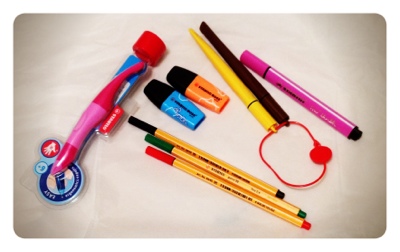It's not only the children who are getting their pencil cases ready for D-day in a fortnight's time; the teachers are too! As I sort out my pencil case and find (amongst other things) cable ties and a piece of the ice palace from the James Bond film Die Another Day, I have realised that I need to restock!
Which is why I was chuffed when Stabilo sent me items from their 'back to school' range.

The thing about Stabilo is that they make reliable, practical and ergonomic stationary. Take for example the Cappi pens on a ring above, the loop keeps all the lids together and stops the pens from wondering in school bags. Or the mini ocean friends highlighters which are perfect for highlighting the all important information to get that school project done.
However, my personal favourite and one that I have used in the classroom with my pupils is the EASY Original ergonomic pen. Thats the pink one in the packaging on the left. It's designed to correct pen grip and therefore aid handwriting. I've discovered (since teaching handwriting) that I don't hold a pen properly myself; I grip it between my thumb, index and middle finger. However with the Easy Original, that's actually impossible, and it does help correct pen grip and handwriting; I've bought it for my pupils to use in the past.
The EASYoriginal is available in all major supermarkets including Sainsbury’s, Morrisons and Tesco, major stationery shops including WH Smith and Rymans and online retailers including Amazon and Cult Pens. Priced at £6.99, it comes with two refills.
I was sent these items for the purpose of this review, my opinion is honest and unbiased.


